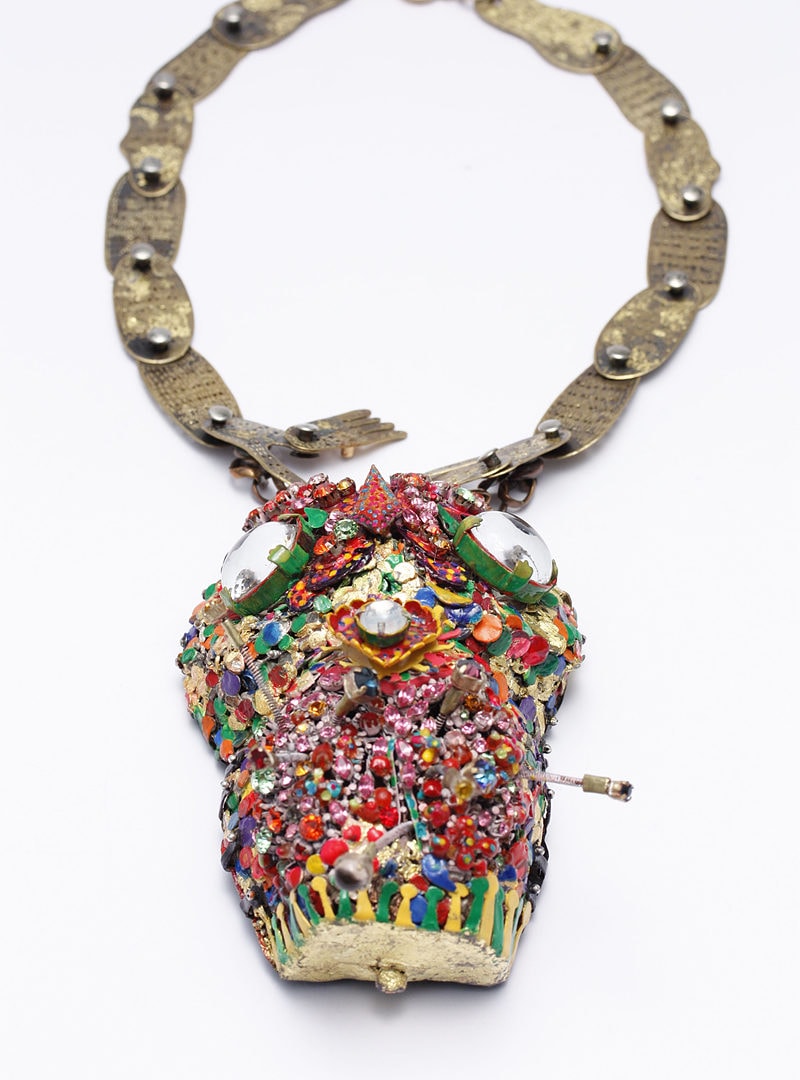It was the day after the opening of the Galerie Marzee graduation show, during the symposium where graduates were invited to present their work. A young Chinese jeweler asked one of the girls in the room to come and sit on a chair in front of him. He, standing behind her, took a golden chain with two large circles at each end and showed it to the audience. It was not a necklace: it had no clasp. But when he put his thumbs through the eyes of the chain and rested his hands on the shoulders of the woman it became a real necklace – for a moment. This wedding necklace exists only when the groom stands behinds the bride. Ren Kai, student of the Central Academy of Arts in Beijing, apparently has no faith in matrimony. His subtle and humorous neckpiece reflects present-day reality in Chinese urban society, a fast-growing society with many new rich and ever-growing divorce numbers. Also his other jewels, with titles such as 10 Years, Because of Love and Persistence, addressed the theme in a humorous way.

Not many graduates are trained in presenting their work to an audience. Somehow they seem less communicative than, for instance, product-design students, which is perhaps inherent in the character of their profession. Not controlling the English language can be another obstacle. For Marie-José van den Hout, the director of Galerie Marzee in Nijmegen, the Netherlands, this is secondary. She noticeably enjoys ‘her youngsters,’ stimulating them to try on a piece in front of the room and to pin or hang the jewel on the next ‘victim,’ the next graduate to come up nervously. This act, like a small ritual, emphasized one of the meanings of jewelry that I appreciate the most: that jewelry is a symbol that can literally be handed over from one person to the other. In this way an atmosphere of openness and receptiveness was created, leaving room for questions and remarks. Another advantage of this ritual is that you can actual see how a piece is worn and how it looks on the body. Van den Hout is very keen on wearability – it is one of her criteria for choosing pieces for the graduation show.
Although there is some confusion about the exact year Galerie Marzee started her famous graduation shows – 1986 or 1987? – it is crystal clear that these yearly exhibitions have developed into an event unprecedented and unequalled. With the gallery’s move in 1995 to a renovated three-story high warehouse on the quay of the river Waal, the initiative gained new impetus. Van den Hout started to travel the world, visiting schools and contacting teachers to find interesting young talent. Over the years, the concept of the ‘graduation show’ has been extended. In 1999, the first Marzee graduation prize was awarded to one student; since 2003, the prize has been awarded to a group of students from different academies, while the awarded graduates have been offered a workshop in Atelier Ravery (Belgium) since 2004. In some years, a symposium is organized on the day after the opening of the show. The idea of the graduation show is, therefore, much more than just showing the work of the next generation. It is about starting your first professional network of colleagues and possible clients, becoming informed about other schools and other ways of thinking, about presenting and competition.
In 1991, Marzee’s graduation show was a modest exhibition involving only six students from three Dutch academies and one German (Pforzheim). Three years later the show had already extended to 32 graduates from eight academies in the Netherlands, Belgium, Germany and Britain. And in 2011, 95 graduates (many of them Asian) from 39 schools are presented in the gallery – that is if I counted well, which isn’t easy with such numbers.

There’s a rather uneven chance to get your work in the show, depending on where you come from. Let me explain. There are different stages of selection and there is an element of chance in the procedure. Some schools have an advantage because van den Hout is able to visit their graduation shows: the three Dutch schools, Düsseldorf, Pforzheim, München, Neurenberg, Halle, Florence, Antwerp (three schools) and London (RCA). In London, van den Hout visits New Designers, a yearly exhibition showcasing 3500 (‘the very best’) design graduates (jewelers among them) from 200 schools in Britain. It is the only way she can get an impression of the output of the many British jewelry schools, since no one is able to visit them all. The rest of the selection is done via the recommendation of teachers and professors at the different schools, while van den Hout decides on the spot which work will be shown. Not all work that has been sent to Nijmegen ends up in the showcases or on the wall. You may wonder why a teacher or van den Hout prefers one pupil/artist over the other, or one work over the other – it is all quite subjective. So chance plays a big role. It must explain why there was only one graduate (Stefan Heuser) representing Otto Künzli’s jewelry class at the Munich Art Academy, with only two works – good works, there is no question about that – but the Munich Academy has more to offer.
Still, the graduation exhibition is fairly representative of worldwide art jewelry by emerging makers in 2011. Looking for a common denominator, my first impression of this year’s graduation show was that of willful amateurism – a trend that has been visible already for a longer time. I also noticed a strong interest in craftsmanship, though not in the traditional sense; gold, silver and precious stones are in the absolute minority today, while wood, paper, textiles and acrylic materials are used widely. 3D designing and printing is not popular at all among jewelry students. This might be a blessing, since it takes a lot of experience, knowledge and artistic creativity to create something really intelligent and smart with computer techniques. Most curriculums run for a maximum of three years, some only two. Nobody can learn jewelry in such a short time, but since the days of the new jewelry and since the days of a new radicalism (as demonstrated in the work of Lisa Walker, Karl Fritsch, Mia Maljojoki and others) everything can be done. Borders are down and even glue and home-made silicon can be a material for jewelry.
Ji-hye Lee’s graduation work from Kookmin University in Seoul shows childish, comic figures made in candy-colored Sculpey clay fixed in semi-soft transparent silicone. A silver pin or a pink ribbon is attached to turn these weird Swamp sceneries into jewelry. I cannot help being somehow moved by the cheeky clumsiness of these large brooches and necklace. The maker is indeed not afraid to make a statement. Ji-hye Lee’s classmates go for the aesthetics, as the beautiful long Paper Chain by Heon-Joo Ji shows. The links are made from a multicoloured and layered solid paper material and this very laborious crafted work establishes quite a difference from the Sculpey polymer puppets. However Seoul’s rebel in jewelry is not a cutting-edge jewelry artist in a global context.

There is work in the graduation show that can be denominated as purposely ‘bad’ or annihilating. Hyoun Jung Sung’s necklace Beobachter (Observer) has a strange big pendant – halfway between a skull and a gasmask – playfully dressed in a thick multicoloured layer of paint, Swarovski stones and gold leaf. This South Korean student of Professor Daniel Kruger from Burg Giebichenstein in Halle, shows a quite painterly and ornamental decorative attitude free of any material or technical goldsmith’s tradition. While Hyoun Jung Sung’s work is forcefully trying to convince, Finnish-Australian Inari Kiuru tries to withdraw from any decorative or appealing criteria. Kiuru, who studied at RMIT in Melbourne, exhibited some large, rather amorphous brooches made from melted composed materials, such as PVC, glue, acrylic paint and resin. The result is quite daring because of their uncompromising non-decorative, non-beautifying character. One needs to have much capacity to make such unappealing work, which anyhow, at a second glance, appears to have beautiful swirling details within the material or on the surface.
Although gold, silver or precious stones are hardly used by the young generation (there are exceptions, of course) a love of craftsmanship is noticeable: Benedikt Fischer from the Rietveld Academy in Amsterdam carves and sculpts second-hand plastic helmets into beautiful shield-like brooches. Each helmet’s surface is dissimilar, reacting differently to being treated with a punch, resulting in a soft and velvety or a prickly skin. The graphical quality of the punched circular patterns enhances the delicacy of each piece. His work can be seen as a contemporary adaptation of the goldsmith’s techniques and concentration. Classmate Atsuno Takase also shows a preference for good craftsmanship. Her delicate white porcelain objects, covered with refined pen-and-ink line drawings, refer to human organs, also expressed in titles such as Ovarium. But they do remind of cabbages and other plants as well. Although the objects are hung in transparent silk nettings, emphasizing their dualistic nature, the artist apparently prefers to hold them in her hands – this was how she presented them at the symposium. Having recently graduated from art school you can still afford to be not yet ready for the big answers, still insecure about the meaning of your work.
We might question whether it is really good news that there are so many young artists engaged in making jewelry all over the world. We can observe waves of students choosing a school because of the name and fame of the professor or teacher, but the name and fame of the teacher is not always a guarantee for good student work. We can see a copy-and-paste attitude, the fast way to join two different materials and forms, we can see real copying and easy solutions. But there is also genuine work that transmits a story, such as the medallions by Agata Bartos, a Polish graduate from the Arnhem art academy, made from crushed (recycled) rosaries, or Shir Pins’s fragile drawings, made from gold and silver alloys, which are reflections of the sounds of her neighborhood in Jerusalem. (She is a graduate of Bezalel, Jerusalem.) To make these pins, entitled They Say There Are Five Entrances to Natan Ha’Navi, she kept a diary. Julia Middleton, from Whitireia Polytechnic, New Zealand, was represented by what she called Recent Relic jewels, made from found technical objects such as switches covered with iron dust. In contrast to the industrial remnants on the front side, she elaborated the rear ‘body’ side of the jewel by adding optical etchings.
The graduation show proves that contemporary jewelry is a global movement. There are some rare exceptions that can be linked to national (or presumed national) characteristics, such as Yasutaka Okamura’s flexible bracelets made from kimono fabric and fine silver.
It is interesting to see that more and more schools all over the world offer jewelry courses, but the result is not particularly enriching in terms of renewal of concepts and methods. We may wonder where all these young jewelers will end up. The Marzee graduation show is not a predictor of who is going to make it in the future. You cannot extract from two or three pieces if a jeweler is really talented, if he or she has enough guts, ideas and endurance to go deeply, if a jewelry infrastructure will develop in Asia and if there are enough clients for so many jewels. Life only starts after graduating.





